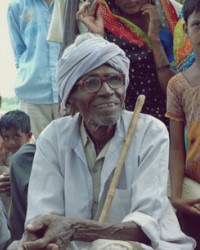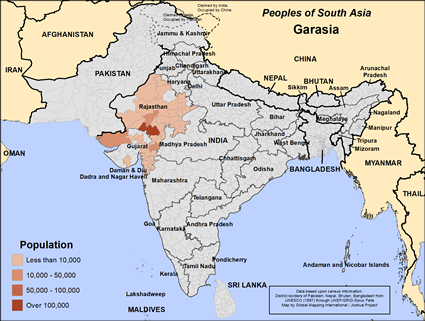Garasia in India

Photo Source:
Anonymous
|

Map Source:
People Group data: Omid. Map geography: UNESCO / GMI. Map Design: Joshua Project.
|
| People Name: | Garasia |
| Country: | India |
| 10/40 Window: | Yes |
| Population: | 389,000 |
| World Population: | 404,000 |
| Primary Language: | Garasia, Adiwasi |
| Primary Religion: | Hinduism |
| Christian Adherents: | 0.15 % |
| Evangelicals: | 0.00 % |
| Scripture: | New Testament |
| Ministry Resources: | Yes |
| Jesus Film: | Yes |
| Audio Recordings: | Yes |
| People Cluster: | South Asia Tribal - Bhil |
| Affinity Bloc: | South Asian Peoples |
| Progress Level: |
|
Introduction / History
The Garasia are dispersed throughout the forested regions of Gujarat and Rajasthan in western central India. Their language, known as Adiwasi Garasia, is an Indo-Aryan language belonging to the Bhil sub-group.
The Rajput Garasia are the descendants of the Rajput who married Bhil women. For that reason, they are a hybrid community with one foot in the “tribal” category and the other in the high-status Rajput category. Some believe they originally were chiefs who were driven from their wealth by invaders. During the thirteenth century, many poor Rajput fled to the Vindhya and Aravalli hills, where they mixed with Bhil settlers. In time, the Garasia defeated the Bhil chiefs and their followers, settling near the foothills and in the forests. There they were given land for cultivation as a reward for protecting the people and the area. The name "Garasia" refers to landholders living in the Gujarat and Rajasthan states.
What Are Their Lives Like?
Among the Garasia, the average land holding is small; therefore, the man of the household is able to do all of the work himself. Maize is the staple food grown by all families. Many also depend on forest produce as a means of support. The people are generally vegetarians and are no longer addicted to alcohol like other Bhil tribes.
The Garasia typically live in one-room houses made with mud and bamboo walls. Those with more money build flat tiled roofs, while the poorer people still use thatch. Houses are usually built on the slopes of hills with their fields extending out in front. There is usually a guest house opposite the house of the headman of the village. There is no central village site where the people meet together. In fact, there is very little unity or cooperation between village clans.
Garasia women are not allowed to own property and are required to wear veils over their faces when in the presence of elder male relatives. Ironically, they are not considered inferior to men. The women's responsibilities include cooking, tending to the cattle, milking the animals, and looking after the children. The men do the physical labor such as plowing, harvesting, and building the houses.
The Garasia are allowed complete freedom in choosing a spouse. Young men between the ages of 18 and 24 usually marry girls that are between the ages of 14 and 18. The two live together without any official marriage ceremony, although this may vary in some regions due to Hindu influence. The Garasia have a "joint family system" in which the sons remain with their families until their own children become adults. Intermarriage with other Bhil tribes is permitted, but cross-cousin marriages are strictly forbidden. A man is allowed to have more than one wife if his first wife is either infertile or bears him no sons.
The Garasia believe that widows bring bad luck to the villagers. Although it is now illegal, some widows will sacrifice themselves in fire for the sake of the villagers. The community then commemorates her noble decision to end her life.
The women love to dress with many silver ornaments. They usually wear black or red blouses with large petticoats. The men are noted for their red or white turbans. Both men and women wear tattoos.
What Are Their Beliefs?
The Garasia people practice Hinduism but their beliefs are heavily influenced by traditional religion. Being a flexible religion, Hinduism can accommodate animism, etc. Hinduism is a catch-all phrase for the local religions of South Asia, so it is very diverse. At the popular level, Hindus worship and serve the gods of the Hindu pantheon. They visit Hindu temples and offer prayers, food, flowers, and incense to their gods in hopes of gaining protection and benefits. They do not have a personal or familial relationship with their gods like Christians or Jews. There are other Hindus who are much more philosophical, especially among the Brahmins.
Almost all Hindus participate in yearly celebrations like Holi, the festival of colors and the start of spring / Diwali, the festival of lights / Navratri, the celebration of autumn / and Rama Navami, Rama's birthday.
What Are Their Needs?
Only a few Rajput have converted to Christianity. More laborers are needed to live and work among these precious people.
Prayer Points
Ask the Lord to call ambassadors for Christ to go to the Garasia people.
Pray for the Holy Spirit to give the Garasia people teachable and understanding hearts.
Pray for the Lord to bless them physically and spiritually as they turn to him.
Pray for the gospel to flood Gujarat and Rajasthan.